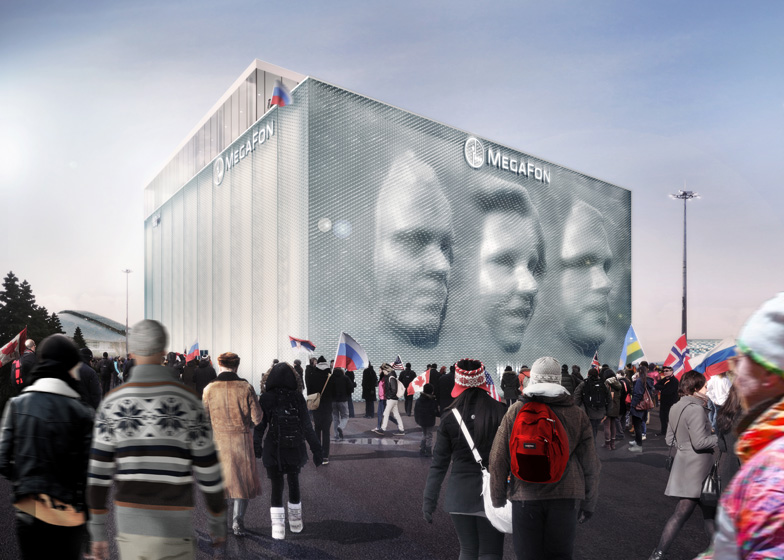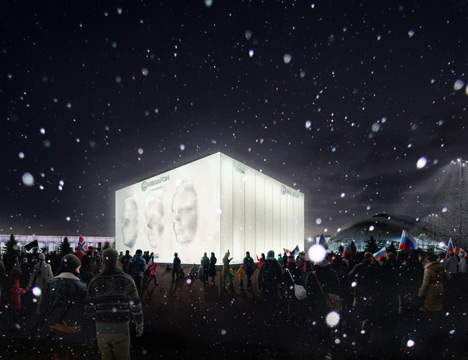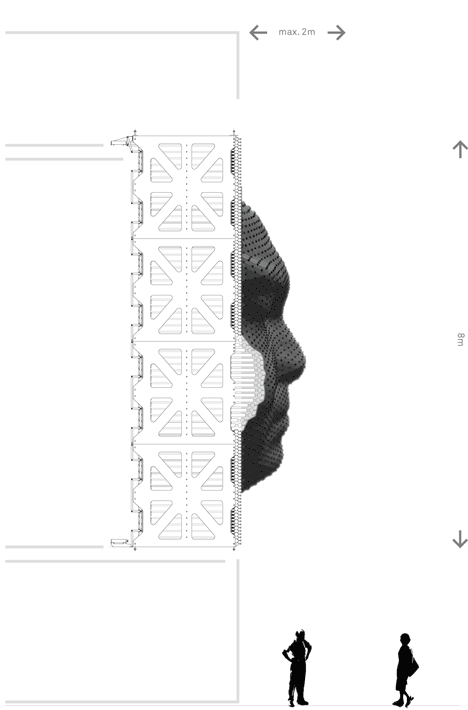When the Sochi Winter Olympics kick off next month (Feb. 7-23) in Russia, the temporary pavilion for Russian telecom operator MegaFon is going to turn a lot of heads—literally.
The company commissioned London-based designer Asif Khan to create a one-of-a-kind installation for the Games. Khan answered with MegaFaces, a 39-foot-high, illuminated façade that acts much like a giant pin screen, replicating the faces of people in the crowd in the form of a 26-foot-high, 3D mural.
The kinetic façade will display three faces simultaneously, and each participant will receive a 20-second video clip of their experience via email.
Here's how it works, according to a report by Dezeen: People step into a 3D photo booth to have their face scanned from five different angles.
Using the data, a computer creates a 3D model of the facial structure (in about a minute) and sends the coordinates to an engine-and-cable system that controls a series of actuators that make up the kinetic portion of the façade. Each one of the 10,000 actuators can extend out to lengths of six feet, allowing for the creation of dramatic, 3D murals.
Don't believe us? See for yourself:
Related Stories
Resiliency | Sep 30, 2022
Designing buildings for wildfire defensibility
Wold Architects and Engineers' Senior Planner Ryan Downs, AIA, talks about how to make structures and communities more fire-resistant.
| Sep 30, 2022
Manley Spangler Smith Architects partners with PBK in strategic merger
Manley Spangler Smith Architects (MSSA), a Georgia-based, full-service architectural firm specializing in educational and municipal facilities, announced today a significant development aimed at increasing its capabilities, expertise, and suite of services.
| Sep 30, 2022
Lab-grown bricks offer potential low-carbon building material
A team of students at the University of Waterloo in Canada have developed a process to grow bricks using bacteria.
| Sep 29, 2022
FitzGerald establishes Denver office
The new location bolsters FitzGerald’s nationwide reach and capitalizes on local expertise and boots-on-the-ground to serve new and existing clients seeking to do business in Denver and the Front Range, as well as the Southwest United States, California, and Texas.
| Sep 28, 2022
New digital platform to foster construction supply chains free of forced labor
Design for Freedom by Grace Farms and the U.S. Coalition on Sustainability formed a partnership to advance shared goals regarding sustainable and ethical building material supply chains that are free of forced labor.
| Sep 27, 2022
New Buildings Institute released the Existing Building Decarbonization Code
New Buildings Institute (NBI) has released the Existing Building Decarbonization Code.
| Sep 23, 2022
High projected demand for new housing prompts debate on best climate-friendly materials
The number of people living in cities could increase to 80% of the total population by 2100. That could require more new construction between now and 2050 than all the construction done since the start of the industrial revolution.
| Sep 23, 2022
Central offices making a comeback after pandemic
In the early stages of the Covid pandemic, commercial real estate industry experts predicted that businesses would increasingly move toward a hub-and-spoke office model.
| Sep 22, 2022
Gainesville, Fla., ordinance requires Home Energy Score during rental inspections
The city of Gainesville, Florida was recently recognized by the U.S. Dept. of Energy for an adopted ordinance that requires rental housing to receive a Home Energy Score during rental inspections.
| Sep 21, 2022
New California law creates incentive for installing outdoor dining safety barriers
A new California law provides an incentive for commercial property owners to install barriers to protect outdoor diners.




















